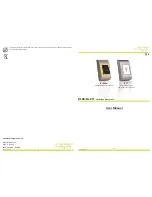
Operating Manual
Page 84 / 116
Copyright © REA Elektronik
REA ScanCheck 3n
V 1.2.0 24/02/2020
REA
VERIFIER
5.6.1.3.1.10 2 of 5 Int IATA / 2 of 5 3 bar matrix / 2 of 5 5 bar ind
- Additional test criteria (optional code types)
The
2/5 Interleaved IATA
was used by the IATA for air freight. It
requires a mandatory check digit. It is possible to choose between
two size ranges. Small is a module size from 10-15mil, large is 20mil.
The
2/5 3 bar matrix
is a special form of the 2/5 Int, the start and
stop characters of which contain an extra-wide bar and therefore
prevent partial reading. With this menu it is possible to switch on
testing of the check digit per Modulo 10.
In
2/5 5 bar Industry
only the 5 bars (2 wide, 3 narrow) are used for
the coding.
Here too, it is possible to switch on testing of the check digit per
Modulo 10.
5.6.1.3.1.11 2 of 5 5 bar IATA - Additional test criteria (optional
code types)
Like the 2/5 Interleaved IATA, the
2/5 Interleaved 5 bar IATA
is
used by the IATA.
Here too, it is possible to switch on testing of the check digit per
Modulo 10.
5.6.1.3.1.12 Pharma Code / Plessey Code - Additional test criteria (optional code types)
REA bar code verifiers use the specifications of Laetus in order to
test
Pharma Codes
.
The specifications of other manufacturers are slightly different (e.g.
the Sick Code).
The decoded value of this code type is different, depending on
whether the code is read from left to right or right to left. The defined
standard reading direction is from left to right. This also reflects the
factory settings with the REA ScanCheck 3.
If this reading direction is to be switched, it is necessary to activate
the selection “Use non-standard reading direction”. This can be very
useful in cases in which the specimen cannot be turned round for
reading.
The Pharma code only knows two sizes. Standard has a module
width of 0.5 mm and Mini Pharma Code is 0.35 mm wide. With the
setting “Automatic”, there is an attempt to determine the correct size autonomously.
The
Plessey code
is a purely binary code type and was defined in 1971. It is still in use today, in
particular in library applications. The Plessey code and MSI code are similar codes, whereby
















































